III. Implementation of the main restoration works (2007-2014)
 @kizhi
@kizhi
While the measures planned for the preparatory period were carried out, the Museum Carpenter’s Center adopted the Restoration Complex and performed an experimental restoration of the granary from the village of Peldozhi, restored some components of the original church floor dating from the XVIII-XIX centuries, started the reconstruction of church foundations and restoration of the iconostasis carved gilt-frame.
III.1 Adoption of the Restoration Complex. Acquisition, installation and adjustment of the woodworking machinery for restoration, 2006-2008
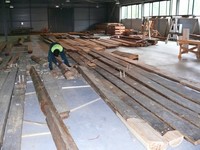
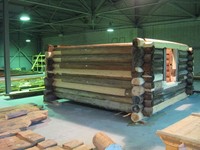
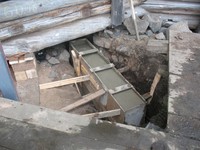
A considerable volume of work on the adoption of the Restoration Complex was done in connection with the preparation for the fulfillment of the mentioned tasks in 2007–2008 and namely:
- placement of the woodworking machinery acquired earlier in manufacturing sequence, linking up in a constant-closed circuit, including:
- contour band saw for log conversion ЛП-60;
- portable saw frame M7 with a power chain saw Е-5000 and a «Логофрез» attachment;
- jointing machine СФ-6;
- circular cutoff saw Ц-6;
- milling machine ВФК;
- machine for drilling and grooving СВПГ;
- inter-machine rolling supports;
- waste disposal system;
- acquired electric tools: electric planes, portable milling cutter, disk power-saws, chain petrol-powered saws, sufficient amount of wood-cutting tools;
- the department intended for restoration was equipped with load lifting mechanisms;
- also available in the Restoration Complex:
- the department for tools preparation and grinding equipped with cutter-grinding machines Rondamat 168 and Tiger-25;
- the department for metalwork and melding;
- aerodynamical drying chamber СКА-10 was mounted and brought into operation.It is intended for bringing humidity of the restored components to restoration conditions.
- heat chamber was equipped in the blank section for agglutinating restored components according to technology developed by Kutcherenko Institute;
- special transfer shuttles were designed and manufactured, they are intended for transporting logs inside the departments;
- log truck «Ural» was acquired for logs’ transportation, it features trailer and hydraulic manipulator;
- high-pressure apparatus KARCHER HD6/13C was acquired for final purification of original logs before the restoration, a washing station for logs was arranged;
- the following items were acquired for conducting preliminary diagnostics of original logs and detecting the sections with internal damage:
- device for detecting wood density;
- radio-metal locator;
- electronic moisture meter;
All of the previous opens up the opportunity to take high-precision measurements timely and detect defects and damage in the original logs to determinate a proper method of restoration. The search for new advanced methods and diagnostic equipment will be kept going.
The implementation of the mentioned measures made it possible to start experimental restoration of the granary from the village of Peldozhi in the Restoration Complex already in June, 2008 and simultaneously set to restoration of the original floor from the Church of the Transfiguration.
III.2 Experimental restoration of the granary from the village of Peldozhi in the Restoration Complex
The log framework of the granary (built in the XVIIIth century) included in list of Kizhi Museum monuments is almost identical in age, method of cutting, degree of preservation and condition of framework components and joints to the framework components of the Church of the Transfiguration, especially 2 nd and 3 rd octahedrons.
Logs in both of the frameworks are noted for a good state of preservation on their inside surface (i. e. facing the interior of the monument), meanwhile their external surface is almost disrupt or even ruined in some parts. The external surface of rows of logs located in the south-eastern portion because they are most liable to sousing from the rain water trickling down the walls and slanting rains during cross winds, and exposed to intensive solar irradiation. Sapwood on the external log surface started cracking as the result of all the reasons mentioned above, water penetrated into the cracks and rather deep tubular mould generated in these parts of the logs; this is quite often the case that water was running all along the logs penetrating into the log joints and the log ends protruding from the corners which contributes to logs rotting.
The granary was disassembled, the logs were carefully inspected and afterwards restoration techniques were developed for each of the logs. The conditions of the Restoration Complex made it possible to use different approaches to methods of restoration. Different techniques of log restoration were used at that: lengthening, putting insertion pieces and grooves applying glue junctions of phenolresorcin glues, preliminary assembling of the log framework inside the assembly department of the Restoration Complex.
The experimental restoration of the granary proved in practice the correctness of the chosen restoration technique for logs and framework assembly, and besides it gave the opportunity to gain work experience of completing such tasks, which helps to prepare for the restoration of the log framework of the Church of the Transfiguration and have well-prepared, qualified carpenters-restorers at disposal.
The process and results of the restoration done on the granary from the village of Peldozhi are stated in the report on the restoration which is available in the archives of Kizhi Museum.
The results of the experimental restoration of the granary using advanced technologies will be presented for the experts’ approval; their conclusion about the quality of the work done, remarks and suggestions will be assumed as a basis when it comes to taking final decision about the restoration technology for the log framework of the Church of the Transfiguration using the experience gained during the restoration work on this object.
III.3 The restoration of the original floor dating from the XVIII-XIX c.

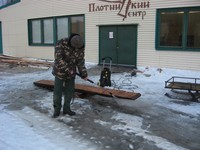
The restoration of the original floor dating from the XVIII-XIX c. took place in 2008. The work was done step-by-step and included the following:
- Cleaning the altar, church proper, refectory and solea portions of the floor from dust and surface contamination with a high-pressure apparatus. The cleaning was done during frost-free season with air drying. An average water discharge was 35–40 liters per component. Moist factors before and 7 days after cleaning didn’t vary in more than 2%.
- The restoration of the altar, northern part of the church proper and solea portions of the floor included the following:
- Extracting defected elements;
- Producing and fixing insertion pieces. The wood from the XVIIIth century or boards made of special timber stocked in 2004 was used for restoration material. When selecting material they took into consideration humidity, physical characteristics and condition of the wood surface;
- Manufacturing, adjusting and fixation of the insertion pieces for joining sawn elements and structural timber lengthening. Fastening insertion pieces on the restored elements was done with adhesive composition КАСКОСИНОЛ 1714/2520 using additional pegs of birch wood. Insertion pieces for lengthwise fixation were produced for the elements liable to jointing with length more than 7 m, these insertion pieces were fixed from one side of the defected elements;
- Crack filling followed by polishing to obtain the ground; it was done for the elements that feature cracks, pinchers and alike minor defects;
- Photos of all the restored elements of the floor half-beams were taken from four sides with the plotting board on the background;
- During the restoration they kept the record of the works done, characteristics of the restored elements, restoration material and tools used, the succession of the restoration procedures;
- The insertion pieces fixed into the floor components feature labeling of «ПЦ» (i. e. Carpenter’s Center), date of the restoration and initials of the person who performed the work;
- The restored elements of the floor portions of the altar and solea are stocked in the storage area, detailed tables and maps of stacking are made; the lower tier is set on the antiseptically treated beams 15×15 cm.placed with 1 m spacings; The rows were interlaid with antiseptical poles (diameter 7–9 cm) treated with sandpaper;
- About 30% of the floors have been restored as of the 1 st of December, 2008. The work is going on.
Date for sections III.4-III.6 is not due yet.
III.7 Reconstruction of the foundation of the Church of the Transfiguration
Section II contains the information concerning the execution of works on providing foundations for the equipment intended for suspension of the engineering restoration tiers within the log framework.
According to design concept these transverse foundations will be integrated into the common strip foundation and perform two functions: 1) acting as supports for the suspension studs; 2) acting simultaneously as counterforts that increase the resistance of the church structure against crawling towards NW direction.
In this way, works on constructing transverse foundations is the first stage of the strip foundation’s reconstruction which will continue in 2009–2010.
Date for sections III.8-III.9 is not due yet.
III.10 Restoration of carved gilt-frame of the Church iconostasis
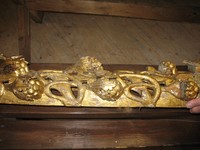
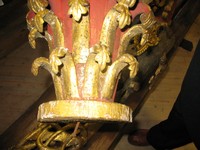
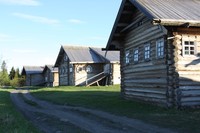
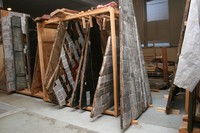
It was supposed that the following problems will be solved in 2008:
- Preliminary evaluation of the costs of all works;
- Ascertainment of sources and forms of financing;
- Appointment of the contractor;
- Testing of the work techniques by the prospective executor;
- Preparation of the workplaces for restorers on Kizhi Island;
- Preparation of the storage facilities for keeping restored components of the iconostasis;
- Preparation of lodging facilities for restorers (contractor’s employees);
- Preparation of museum icon-restorers for monitoring the condition of the iconostasis, and performing some of the restoration works;
- Preparation of the documents in which the condition of the iconostasis components and fragments is described before the restoration starts;
- Including the works on restoration of the iconostasis of the Church of the Transfiguration into special archival activities of «Kizhi» Museum;
- Beginning of the restoration in case of financing provision.
a). Estimation of the work costs, sequence and stages. Ascertainment of funding sources and forms of financing. Regional Department of Restoration (МНРХУ, Moscow) made «Technical and economic assessment of the costs (feasibility study) «for conservation and restoration works on strengthening gilded surface of the iconostasis. This assessment is based on the measurements taken on the gilded carved surface of the iconostasis. According to calculations, total cost of the gilding conservation is 31.513.000 rubles.Besides, Regional Department of Restoration promised to make technical and economic assessment of the costs (feasibility study) «for the restoration of carvings. According to a preliminary estimate this should increase the costs 30%. Although the representatives of Regional Department of Restoration (МНРХУ, Moscow) promised to make assessment of all the costs, they didn’t take the final restoration stage into consideration, namely installation of the iconostasis inside the Church of the Transfiguration.
These works are beyond the scope of restorers and should be performed by the chief designer of the Complex Restoration.
The project on conservation and restoration works on gilded carved frame of the iconostasis is to be implemented in 2009–2014 in 7 stages.
Taking into account target numbers for restoration costs (30%) we received the following results:
| Stage. | Period. | Scope of work | Costs of the conservation and gilding (in thousands rub.) | Costs of the restoration of the iconostasis carving (in thousands rub.) | Total cost of the restoration of the gilded iconostasis frame (in thousands rub.) |
|---|---|---|---|---|---|
| 1 st stage | 2009 | Panels above the local tier | 3585,2 | 1075,6 | 4660,8 |
| 2 nd stage | 2010 | the Local tier | 6221,4 | 1866,4 | 8087,8 |
| 3 rd stage | 2011 | the Royal Doors | 2645,5 | 793,7 | 3439,2 |
| 4 th stage | 2012 | the Deisis tier | 8306,2 | 2491,9 | 10798,1 |
| 5 th stage | 2013 | the Festive tier | 3541,0 | 1062,3 | 4603,3 |
| 6 th stage | 2014 | the Prophets tier | 3175,0 | 952,5 | 4127,5 |
| 7 th stage | 2014 | Ciborium above the communion table | 4039,1 | 1211,8 | 5250,9 |
| Total: | 31513,4 | 9454,2 | 40967,6 |
This total amount of 40.967,6 rubs. is the approximate size of financial needs for preparing iconostasis frame for installation inside the church.
The operational meeting attended by the representatives of the concerned museum departments and the Chief architect of the Project for Complex Restoration of the Church of the Transfiguration Rachmanov V. S. was held in April, 2008. At that meeting they discussed different ways of financial problem-solving related to the restoration of the iconostasis. The final conclusion drawn at the meeting implied that the iconostasis restoration should be included into the whole restoration programme for the Church of the Transfiguration.It is necessary to prepare a series of specific documents for this purpose summarized in a special section (a volume) of a whole programme. The management of this work was entrusted to Rachmanov V. S. In his opinion, a detailed description of the integrity of each iconostasis fragment or structural element made prior to restoration is necessary to explain the financial needs. The descriptions available in the museum archives are just simple registration cards; they are incomplete and differ from the records made prior to restoration. Much time is needed to draw up this document. This is why the request for financing works on programme «Culture of Russia» was compiled and sent to the Ministry of Culture of Russian Federation in August, 2008, by agreement with the Economy Department of Kizhi Museum. The requested amount of financing is 40 967, 6 thousand RUB. ; the financing term is 2009–2014. The results are not known yet.
b). Appointment of the Contractor. Previously the museum considered Regional Department of Restoration (МНРХУ) as a prospective contractor. This organization performed the conservation of gilding on the turn of 1970–1980, МНРХУ have been restoring icons for many years. On the whole, МНРХУ showed strong desire for collaboration with the museum. At the present time МНРХУ is finishing contract works on testing restoration technique on the four consoles of the carved iconostasis i. e. trial works according to the approved method are being performed at the moment, the financing source are internal museum funds. However, the collaboration with this organization during last two-three years also revealed some negative aspects such as unreliability. For example, cost estimating for carvings restoration was to be made until spring, 2008, but it is not available until today. МНРХУ is willing to work on the island during 2 summer months only. The cost of some works is considerably higher than for the similar works performed by different organization.
c) Creating favourable conditions for restoration work, storage of the restored parts and living accommodations for restorers.
During 2008 internal and external electric network was provided for the buildings located on Pudozh sector.Besides, they kept on restoration work on Belyaev’s house; this is the principal place of works execution and storage for parts after the restoration. The rooms of the summer house were repaired and adapted for living of two specialists. Carpenter’s Center produced a restoration rack for large fragments of the iconostasis.
Problems with the buildings:
- The restoration of the buildings is not complete. In the course of the restoration there have been detected the malfunctions that need repairs. After removal of the coating that covered the habitable section of the house it turned out that logs in the walls were fitted not properly, and a log framework features reach-through chinks. Floor boards are fitted poorly.It is necessary to plank wall with some material to correct these defects. The section meant for household structures needs protection from dust, rain, snow and birds. The internal electric network is installed, and this worsens the situation.It will be necessary to remove it before planking walls and ceilings and then mount anew. It was supposed that some work on the iconostasis restoration would be performed in two different buildings on Pudozh sector. Potashev’s house gives rise to strong anxiety.Its section meant for household structures is in such a bad condition that storing of the iconostasis details and icons without any additional protection of the walls becomes impossible. Problems of preparation monuments on Pudozh sector were discussed with the Department of Chief curator of immovable monuments and Deputy Director of restoration (last discussion took place in October, 2008). They took the decision that Chief curator of immovable monuments A. J. Lyubimtsev would state the suggestions on the scope of work and volume of the required materials, and besides on the involvement of the qualified executors.
- Living area in the summer house is rather small. Additional lodging is necessary for at least three expert-restorers in summer time. The suggestion of purchasing an accommodation module (or a wagon) which could be located in the restores’ settlement is still acute.
d). Preparation of museum icon-restorers for monitoring the condition of the iconostasis, and performing certain restoration work. Museum wood-restorers I. L. Kozhevnikov and I. G. Gashkov received training in Russian Ethnographical Museum in spring, 2008, following which got down to restoration of separate details of the iconostasis frame which were damaged or completely lost. The rating of the work done proved that it was performed up-to-high proficiency level which gives hope that such work on restoration of the iconostasis frame can be completed by museum carvers, in case the issues of organization and worthy payments are settled. At the same time, there have been held preliminary talks on collaboration with the most famous restorer of the iconostasis carvings in Russia G. A. Preobrazhenskaya. She agreed to inspect the iconostasis and consult about restoration of carvings. However, her visit was held over till the next year because of the illness.
e). Preparation of the documents on which the condition of the iconostasis components and fragments is described. The Department of Restoration of the Museum Funds started describing condition of the iconostasis components and fragments in the documents. The principle of description has been elaborated. There have been made descriptions of seven large components (panels) of the disassembled iconostasis.
f). Including the works on restoration of the iconostasis of the Church of the Transfiguration into special archival activities of «Kizhi» Museum.
The governing body of the museum took the decision that the supervision of all the problems related to the restoration of the iconostasis of the Church of the Transfiguration shall be included into the administrative duties of G. I.Frolova, museum restorer.
III.11. Restoration of the iconostasis paintings in the Church of the Transfiguration
The icons were taken down from the iconostasis of the Church of the Transfiguration for storing in 1980; their condition is controlled by the museum custodians. The icons are restored when needed, this is why their safety is guaranteed, and sometimes measures on preservations must be taken to preserve icons condition. The volume and nature of these measures will be clear in the mid-term of the restoration i. e. closer to the moment of installation into the iconostasis frame.
For reference: it is obligatory that the work on conservation on the icons of such value must be performed once in 10–15 years, or even oftener for some of the icons. Icons of the Local tier obviously need some restoration.
Museum restorer Kuusela N. S.completed study course of «Restoration of the Old-Russian Paintings» in ВХНРЦ им. И. Э. Грабаря in November, 2008, which opens up the opportunity to raise the level of attainment and performance quality of promising young specialists, ready to help in restoration of the iconostasis paintings in the the Church of the Transfiguration.
